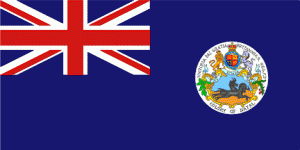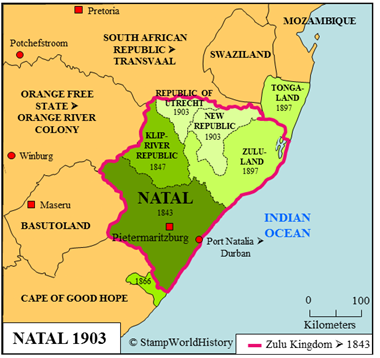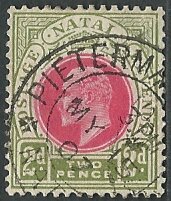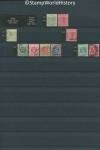
Natal
Quick reference
General issues: British colony 1857-1910
Country name on general issues: Natal
Currency: 1 Pound = 20 Shilling, 1 Shilling = 12 Pence 1857-1910
Population: 925 000 in 1901
Political history Natal
Natal is located in southern Africa. Natal was given its name by the Portuguese explorer Vasco da Gama, who passed the Natal coast on Christmas 1497 – Natal is the Portuguese word for Christmas. In the early part of the 19th century, the Zulu – one of the Bantu peoples in southern Africa – had formed the Zulu kingdom encompassing most of the future Natal. The first Europeans to settle in the Zulu kingdom were the British in Port Natalia, the current Durban. Next to settle in the Zulu kingdom are the Boers who – during the Great Trek from Cape of Good Hope inland – in 1842 establish the republic of Natalia. The British oust the Boers in 1843 to establish the British colony of Natal – the Boers trekking further inland. Natal will be annexed to Cape of Good Hope from 1844 until 1856 when Natal is reestablished as a separate colony.
The borders of Natal will be adjusted a number of times between 1843 and 1910:
- In 1847, the Klip River Republic is annexed to Natal. The Klip River Republic was founded on Zulu territory earlier in 1847 by Boers leaving Natal to resettle further inland.
- In 1897, Zululand and Tongaland are annexed to Natal. Zululand was the remainder of the Zulu kingdom that, after the Zulu wars and prior to annexation, had become a British colony in 1887. Tongaland – home of the Tonga, another one of the Bantu peoples in southern Africa – became a British protectorate in 1895.
- Finally, after the Second Boer War in 1903, two former Boer republics established on Zulu territory – the Republic of Utrecht and the New Republic – are annexed to Natal. The Republic of Utrecht was founded by the Boers in 1852 and had become part of the South African Republic in 1858. The New Republic was founded by the Boer in 1884 in the wake of the Zulu wars and equally had become part of the South African Republic in 1888.
The colony of Natal became part of the Union of South Africa in 1910. Today the former colony of Natal forms the province of KwaZulu-Natal in South Africa. The Zulu are, until today, the largest population group in Natal. A substantial minority is formed by the descendants of Indian workers that the British had brought to Natal. Durban has developed to be the second largest city in South Africa after Cape Town.
Postal history Natal
The first stamps for Natal are issued in 1857. The first issues are embossed – as expensive as they are unique. Subsequent issues are of the standard designs for the British colonies. The stamps of Natal are, from 1910, superseded by the issues of South Africa. Before annexation to Natal, the New Republic and the colony of Zululand had issued stamps.
Album pages
← Previous page: NamibiaNext page: New Republic →



